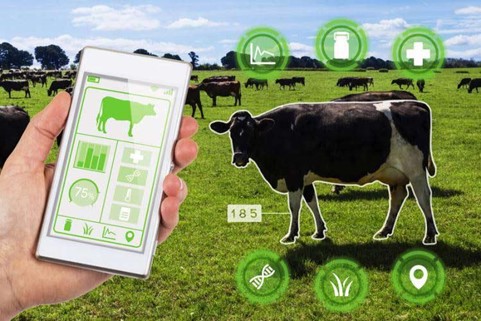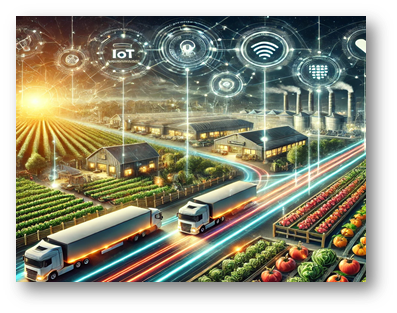How can AI improve livestock health monitoring and food supply chain efficiency?

How can AI improve livestock health monitoring and food supply chain efficiency?
by Maximilian 02:23pm Jan 31, 2025

Improving food supply chain efficiency means reducing waste, lowering costs, speeding up delivery times, and ensuring food safety and quality. This can involve better logistics, advanced technologies like blockchain or AI for traceability, improved storage conditions, and streamlined transportation.
Together, livestock health monitoring and food supply chain efficiency can improve both the quality of food produced and the sustainability of the food system. By monitoring livestock health, farmers can prevent disease outbreaks and ensure high-quality products, which ultimately helps optimize the entire food supply chain, reducing waste, and improving food security.
AI has the potential to significantly improve both livestock health monitoring and food supply chain efficiency. Here's how:
1. Improving Livestock Health Monitoring
a. Real-Time Health Tracking
Wearable Sensors: AI-powered devices monitor vital signs like heart rate, temperature, and activity levels in real-time, detecting abnormalities early.
Computer Vision: Cameras combined with AI analyze animal behavior, gait, and posture to identify signs of illness or stress.
b. Disease Detection and Prevention
Early Diagnosis: AI models analyze patterns in health data to detect diseases before symptoms become severe.
Predictive Analytics: AI predicts outbreaks by correlating weather, feed quality, and health records, enabling preventive measures.
c. Nutrition Optimization
Customized Diet Plans: AI tailors feeding schedules and nutrient compositions based on each animal’s age, weight, and health status.
Feed Efficiency: Algorithms optimize feed usage, reducing waste and improving overall health and productivity.
d. Reproductive Health Management
Estrus Detection: AI identifies optimal breeding times by analyzing behavioral and physiological data.
Genetic Insights: AI assists in selecting animals for breeding based on genetic data to enhance traits like disease resistance and productivity.
e. Stress and Welfare Monitoring
Environmental Analysis: AI systems monitor barn conditions (temperature, humidity, air quality) and adjust settings to reduce stress.
Behavioral Analysis: Identifying signs of discomfort or aggression, enabling timely intervention.

2. Enhancing Food Supply Chain Efficiency
a. Inventory and Demand Forecasting
Accurate Predictions: AI forecasts demand for perishable products, reducing overproduction and food waste.
Dynamic Pricing: Adjusting prices based on demand, supply, and shelf life to optimize sales and reduce spoilage.
b. Logistics Optimization
Route Planning: AI optimizes delivery routes for transporting livestock or food products, saving fuel and time.
Cold Chain Management: Monitoring temperature and humidity during transport ensures food safety and reduces spoilage.
c. Traceability and Transparency
Blockchain Integration: AI integrates with blockchain to provide end-to-end traceability, ensuring food quality and safety.
Real-Time Tracking: AI tracks shipments and provides updates on location, condition, and expected delivery times.
d. Quality Control
Defect Detection: AI systems use computer vision to identify defects or contamination in food products during processing.
Shelf-Life Prediction: Predicting the remaining freshness of perishable items to prioritize distribution.
e. Waste Reduction
Surplus Management: AI identifies surplus food and connects it to redistribution networks or alternative markets.
Processing Efficiency: Optimizing production lines to reduce material loss during food processing.

3. Integrated Benefits
Sustainability
Reducing resource use in livestock management and food production by optimizing processes.
Minimizing waste throughout the supply chain.
Food Safety
Ensuring compliance with health standards through real-time monitoring and predictive insights.
Cost Efficiency
Reducing operational costs by automating routine tasks and optimizing resource allocation.
Improved Consumer Trust
Enhancing transparency and accountability in the food supply chain through AI-driven traceability.

Challenges to Address
While the benefits are immense, challenges include:
Data Collection: Ensuring accurate and consistent data from farms and supply chains.
Adoption Costs: High initial investment in AI tools and infrastructure.
Privacy Concerns: Protecting sensitive data, especially in integrated supply chain systems.
Regulatory Compliance: Adhering to local and international regulations for AI and food safety.
Conclusion
AI transforms livestock health monitoring by enabling early disease detection, stress management, and optimized nutrition. It enhances food supply chain efficiency through predictive analytics, traceability, and logistics optimization. Together, these advancements contribute to a more sustainable, secure, and efficient agricultural ecosystem.






